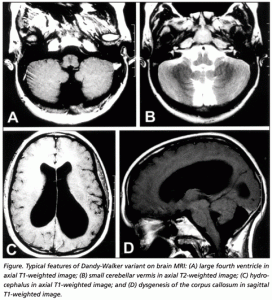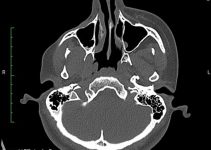What is Dandy Walker Syndrome?
Page Contents
Dandy Walker Syndrome refers to a congenital brain malformation that involves the cerebellum and the spaces in and around the same that it filled with the cerebrospinal fluid. It derives its name from Walter Dandy and Arthur Earl Walker, who are considered the founding fathers of Neurosurgery. The disorder is characterized by an enlargement of the fourth ventricle, the complete or partial absence of the cerebellar vermis, i.e., the area of the brain in between the two hemispheres, and the formation of a cyst in the internal base area of the skull. Due to this it is also known as Dandy Walker Cyst Syndrome. Along with these features, it may also be distinguished by an increase in the pressure of blood flow to the brain and the shrinking of the spaces for fluid retention or even the abnormal accumulation of cerebrospinal fluid. This condition is known Hydrocephalus and when it causes dandy Walker Syndrome, the syndrome comes to be known as Dandy Walker Syndrome Hydrocephalus.
Also known as Dandy Walker Malformation Syndrome or Dandy Walker Complex, the genetically sporadic disorder may be responsible for abnormalities associated with the Central Nervous System (CNS). The Dandy Walker Syndrome is quite prevalent especially among the fairer sex all over the world.
Types of Dandy Walker Syndrome
There are basically three types of dandy walker syndrome which represent different kinds of brain and CNS abnormalities. They may be classified as Dandy Walker Malformation Syndrome, Dandy Walker Cisterna Magna Syndrome, and Dandy Walker Variant Syndrome.
The former is the most severe kind of dandy walker syndrome wherein the posterior cranial fossa containing the brainstem and the cerebellum, is enlarged. Along with this, the cerebellar tentorium separating the cerebellum from the occipital lobes gets lifted. Moreover, in this case the cerebellar vermis, which is the posterior midline area between the two hemispheres is either partially present or completely absent in merely a rudimentary form. It is basically caused by the dysplasias of the brainstem nuclei. One can also detect cyst formation in the fourth ventricle which in fact fills the posterior fossa. Hydrocephalus may occur in this case which entails the abnormal accumulation of cerebrospinal fluid in the brain ventricles and cavities. This may result in increased intracranial pressure inside the skull and other related abnormalities. Genetic disorders such as Spina bifida or Myelomeningocele, which is a congenital spinal disorder, may also lead to Dandy Walker Syndrome.
The other type of Dandy Walker Syndrome is Mega cistern magna, in which case the openings in the meninges, known as cerebellomedullary cisterns are enlarged along with posterior fossa. In this case, the cerebrospinal fluid gets accumulated in the cistern magna of the posterior fossa.
The third type of dandy walker syndrome is the variant. It is a mild disorder characterized by a mild enlargement of the posterior fossa and the fourth ventricle. The cerebellar vermis is underdeveloped and one may exhibit either Hydrocephalus or supratentorial CNS problems. Unlike in the first type of Dandy walker Syndrome, wherein torcular-lamboid inversion occurs, one may not experience the same in case of the variant type.
Dandy Walker Syndrome Symptoms
The symptoms of dandy walker syndrome may either develop slowly without getting noticed or may appear dramatically.
One who suffers from slow motor development, progressive skull enlargement, also known as progressive macro crania, and bulging anterior fontanelle in infancy may be considered to suffer from Dandy Walker Syndrome. Children with the same are noticed to suffer from vomiting, hyperirritability and convulsions due to enhanced intracranial pressure. Both children and adults suffer from cerebellar dysfunction disorders such as ataxia or poor coordination of the muscles, unsteadiness, eye, face and limb jerks, protrusion of the skull from the back, increase of the head size and its circumference, and abnormality in the pattern of breathing, also known as Bradypnea. Children specifically suffer from hyperactivity, nocturnal enuresis, stereotypical movements and other conduct disorders, which are the signs of dandy walker syndrome.
Along with the aforementioned, there may be various other symptoms of dandy walker syndrome such as congestion of the scalp veins, the swelling of the optic disk and reduced width of the occipital squama, and the separation of the cranial sutures.
However, the disease may exhibit more symptoms when associated with other disorders or diseases related to the CNS or the brain.
Dandy Walker Syndrome Causes
Although the exact cause of dandy walker syndrome has still not been unearthed, yet one may attribute the complications involved to genetic and environmentally influenced factors.
The genetic complications involve chromosomal anomalies or Mendilian. In such a case, the improper functioning of the cilia affects the signalling capacity of the motor nerves. Genetic disorders such as Spina bifida or Myelomeningocele may also be responsible for the same. It is for this reason that it forms one of the primary ciliopathic diseases.
Environmental factors include exposure to viruses such as rubella, warfarin or toxoplasmosis and cytomegalovirus, while one is still in the mother’s womb. However, highly discernable variation has been noticed in genetic factors and aetiology that trigger the same.
Besides these aforementioned causes of dandy walker syndrome, the disorder may also be associated with other CNS and brain problems such as hydrocephalus, atresia of the foramen of Luschka and Magendie, corpus callosum, and malformations of the face, heart, fingers, limbs and toes. Recent studies have revealed that dandy walker syndrome may be a concomitant for PHACES syndrome, an abbreviation for Posterior fossa; Haemangioma; Arterial lesions of the neck and head; Cardiac abnormalities; Eye abnormalities and Sternal defect.
Dandy Walker Syndrome Diagnosis

Picture 1 – Dandy Walker Variant
Source – scielo.br
Dandy Walker Complex is a complicated disease which can be diagnosed only with the help of advanced imaging tests such as an MRI scan of the brain, or a CT scan. Dandy Walker Malformation Syndrome and the Cisterna Syndrome require advanced diagnostic methods whereas, the nature of Dandy Walker Syndrome Variant is mild and so can be diagnosed by an antenatal ultrasound test.
Dandy Walker Syndrome Treatment
Dandy Walker Syndrome may be treated with the process of shunting in order to reduce the intracranial pressure. In this process, a special tube is placed in the skull, for the purpose of shunting the posterior fossa cyst in order to facilitate the flow of cerebrospinal fluid and to curb its excess accumulation. In case of Ventriculoperitoneal problems, it is necessary to shunt the lateral ventricles. This technique primarily intends to reduce the swelling involved in any case related to the parts of the brain.
The other techniques of treatment include physical therapy, occupational therapy, speech therapy as well as vision therapy.
Treating the syndrome automatically involves the treatment of other associated problems. One such technique is seizure management.
Along with these, progenitors of those affected with Dandy Walker Syndrome may also reap benefits from a genetic counselling, which shall make them cautious of the problems that may be associated with future births.
Dandy Walker Syndrome Prognosis
The prognosis of dandy walker syndrome depends on the grimness of the situation as well as on the progress of the associated malformations. There is no single likely outcome of dandy walker syndrome owing to the complexity of the disorder. Cases where infants are involved, the mortality rate at both pre and post natal stage is high. These cases are related with dandy walker malformation syndrome.
Children who suffer from mild version of this syndrome may hope to get back their normal intellectual ability or IQ. But for those who may be suffering from severe versions of this disorder may become mentally retarded. However, the presence of multiple congenital defects may lead to reduced lifespan for all irrespective of the age of the sufferer.
Although there are high chances of survival, yet being a congenital brain disorder, Dandy Walker Syndrome may have strong repercussions on the intellectual or mental and physical abilities of the individual. Therefore, it is of great importance that one gets it treated under the aid and advice of brain and CNS specialists, nerve specialists or stroke and vascular specialists, as the case may be, as soon as it comes to light. But in cases where one may trace the roots of the syndrome to genetic disorders, efforts are still being made to come up with a complete treatment, since one can still not be cured of the scourge today.
References :
Wikipedia

